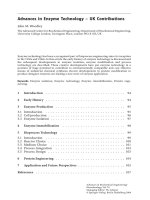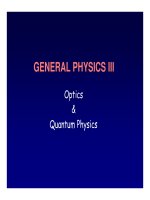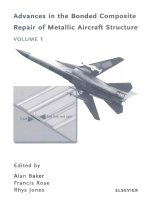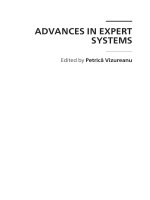- Trang chủ >>
- Khoa Học Tự Nhiên >>
- Vật lý
advances in nuclear physics.. v. 24
Bạn đang xem bản rút gọn của tài liệu. Xem và tải ngay bản đầy đủ của tài liệu tại đây (3.19 MB, 225 trang )
ADVANCES IN
NUCLEAR PHYSICS
VOLUME 24
CONTRIBUTORS TO THIS VOLUME
W. Parker Alford
University of Western Ontario
London, Ontario,Canada, and
TRIUMF
Vancouver,British Columbia,Canada
M. Kamimura
Department of Physics
Kyushu University
Hakozaki,Fukuoka,Japan
K. Nagamine
High Energy Accelerator Research Organization (KEK)
Tsukuba-shi,Ibaraki-ken,Japan,and
The Institute of Physical and Chemical Research (RIKEN)
Wako,Saitama,Japan
Joseph Speth
lnstitut für Kernphysik
Forschungzentrum Jülich
Jülich,Germany,and
lnstitut für Theoretische Kernphysik
Universität Bonn
Bonn,Germany
Brian M. Spicer
School of Physics
University of Melbourne
Parkville,Victoria, Australia
A. W. Thomas
Department of Physics and Mathematical Physics and
Institute for Theoretical Physics
The University of Adelaide
Adelaide,South Australia,Australia
A Continuation Order Plan is available for this series. A continuation order will bring delivery of
each new volume immediately upon publication. Volumes are billed only upon actual
shipment. For further information please contact the publisher.
ADVANCES IN
NUCLEAR PHYSICS
Edited by
J. W. Negele
Center for Theoretical Physics
Massachusetts institute of Technology
Cambridge, Massachusetts
Erich Vogt
Department of Physics
University of British Columbia
Vancouver, British Columbia, Canada
VOLUME 24
KLUWER ACADEMIC PRESS • NEW YORK, BOSTON, DORDRECHT, LONDON, MOSCOW
eBook ISBN:
Print ISBN:
0-306-47073-X
0-306-45757-1
©2002 Kluwer Academic Publishers
New York, Boston, Dordrecht, London, Moscow
All rights reserved
No part of this eBook may be reproduced or transmitted in any form or by any means, electronic,
mechanical, recording, or otherwise, without written consent from the Publisher
Created in the United States of America
Visit Kluwer Online at:
and Kluwer's eBookstore at:
ARTICLES PUBLISHED IN EARLIER VOLUMES
Volume 1
The Reorientation Effect • J. de Boer and J. Eichler
The Nuclear SU 3 Model • M. Harvey
The Hartree-Fock Theory of Deformed Light Nuclei • G. Ripka
The Statistical Theory of Nuclear Reactions • E. Vogt
Three-Particle Scattering- Review of Recent Work on the Nonrelativistic Theory •
A
I. Duck
Volume 2
The Giant Dipole Resonance • B. M . Spicer
Polarization Phenomena in Nuclear Reactions • C. Glashausser and J. Thirion
The Pairing-Plus-Quadrupole Model • D. R. Bes and R. A. Sorensen
The Nuclear Potential • P. Signell
Muonic Atoms • S. Devons and I. Duerdoth
Volume 3
The Nuclear Three-Body Problem • A. N. Mitra
The Interactions of Pions with Nuclei • D. S. Koltun
Complex Spectroscopy • J. B. French, E. C. Halbert, J. B. McGrory, and S. S. M. Wong
Single Nucleon Transfer in Deformed Nuclei • B. Elbeck and P. O. Tjøm
Isocalar Transition Rates in Nuclei from the (α, α') Reaction A. M. Bernstein
Volume 4
The Investigation of Hole States in Nuclei by Means of Knockout and Other Reactions •
Daphne F. Jackson
High-Energy Scattering from Nuclei • Wieslaw Czyz
Nucleosynthesis by Charged-Particle Reactions • C. A . Barnes
Nucleosynthesis and Neutron-Capture Cross Sections • B. J. Allen , J. H. Gibbons, and
R. L. Macklin
Nuclear Structure Studies in the Z = 50 Region • Elizabeth Urey Baranger
An s-d Shell-Model Study for A = 18 -22 • E. C. Halbert, J. B. McGrory,
B. H. Wildenthal. and S. P. Pandy
Volume 5
Variational Techniques in the Nuclear Three-Body Problem • L. M. Delves
Nuclear Matter Calculations • Donald W. L. Sprung
Clustering in Light Nuclei • Akito Arima, Hisashi Horiuchi, Kuniharu Kubodera, and
Noburu Takigawa
V
vi
Artlcles Published In Earlier Volumes
Volume 6
Nuclear Fission A . Michaudon
The Microscopic Theory of Nuclear Effective Interactions and Operators • Bruce R. Barrett
and Michael W. Kirson
Two-Neutron Transfer Reactions and the Pairing Model • Ricardo Broglia, Ole Hansen,
and CIaus Riedel
•
Volume 7
Nucleon-Nucleus Collisions and Intermediate Structure • Aram Mekjian
Coulomb Mixing Effects in Nuclei: A Survey Based on Sum Rules • A. M. Lane and
A. Z. Mekjian
The Beta Strength Function • P. G. Hansen
Gamma-Ray Strength Functions • G. A. Bartholemew, E. D. Earle. A. J. Ferguson.
J. W. Knowles, and M . A. Lone
Volume 8
Strong Interactions in Λ-Hypernuclei • A. Gal
Off-Shell Behavior of the Nucleon-Nucleon Interaction • M. K. Strivastava and D. W. L.
Sprung
Theoretical and Experimental Determination of Nuclear Charge Distributions • J. L. Friar
and J. W. Negele
Volume 9
One- and Two-Nucleon Transfer Reactions with Heavy Ions • Sidney Kahana and A. J .
Baltz
Computational Methods for Shell-Model Calculations • R. R. Whitehead, A. Watt, B. J.
Cole, and I. Morrison
Radiative Pion Capture in Nuclei • Helmut W. Baer, Kenneth M. Crowe. and Peter Truöl
Volume 10
Phenomena in Fast Rotating Heavy Nuclei • R. M. Lieder and H. Ryde
Valence and Doorway Mechanisms in Resonance Neutron Capture • B. J. Allen and
A. R. de L. Musgrove
Lifetime Measurements of Excited Nuclear Levels by Doppler-Shift Methods •
T. K. Alexander and J. S. Forster
Volume 11
Clustering Phenomena and High-Energy Reactions • V. G. Neudatchin, Yu. F. Smirnov, and
N. F. Golovanova
Pion Production in Proton-Nucleus Collisions • B. Holstad
Fourteen Years of Self-consistent Field Calculations: What Has Been Learned •
J. P. Svenne
Hartree-Fock-Bogoliubov Theory with Applications to Nuclei • Alan L. Goodman
Hamiltonian Field Theory for Systems of Nucleons and Mesons • Mark Bolsterli
vll
Articles Published In Earlier Volumes
Volume 12
Hypernetted-Chain Theory of Matter at Zero Temperature • J. G. Zabolitzky
Nuclear Transition Density Determinations from Inelastic Electron Scattering
. Jochen Heisenberg
High-Energy Proton Scattering • Stephen J. Wallace
Volume 13
Chiral Symmetry and the Bag Model: A New Starting Point for Nuclear Physics •
A. W. Thomas
The Interacting Boson Model • A. Arima and F. Iachella
High-Energy Nuclear Collisions • S. Nagamiya and M. Gyullasy
Volume 14
.
Single-Particle Properties of Nuclei Through (e, e´p) Reactions Salvatore Frullani and
Jean Mougey
Volume 15
Analytic Insights into Intermediate-Energy Hadron-Nucleus Scattering • R. D. Amado
Recent Developments in Quasi-Free Nucleon Scattering • P. Kitching, W. J. McDonald,
Th. A. J. Maris, and C. A. Z. Vasconcellos
Energetic Particle Emission in Nuclear Reactions • David H. Boal
Volume 16
The Relativistic Nuclear Many-Body Problem • Brian D. Serot and John Dirk Walecka
Volume 17
P-Matrix Methods in Hadronic Scattering • B. L. G. Bakker and P. J. Mulders
Dibaryon Resonances • M. P. Locher. M. E. Saino. and A. Š varc
Skyrmions in Nuclear Physics • Ulf-G. Meissner and Ismail Zahed
Microscopic Description of Nucleus-Nucleus Collisions • Karlheinz Langanke and
Harald Friedrich
Volume 18
.
Nuclear Magnetic Properties and Gamow-Teller Transitions A. Arima, K. Shimizu,
W. Bentz, and H. Hyuga
Advances in Intermediate-Energy Physics with Polarized Deuterons J. Arvieux and
J. M. Cameron
pp Interaction and the Quest for Baryonium C. Amsler
Radiative Muon Capture and the Weak Pseudoscalar Coupling in Nuclei M. Gmitro and
P. Truöl
Introduction to the Weak and Hypoweak Interactions T. Goldman
.
.
.
.
vlll
Articles Published in Earlier Volumes
Volume 19
.
Experimental Methods for Studying Nuclear Density Distributions C. J. Batty, H. J. Gils,
and H. Rebel
The Meson Theory of Nuclear Forces and Nuclear Structure R. Machleidt
.
Volume 20
.
Single-Particle Motion in Nuclei C. Mahaux and R. Sartor
Relativistic Hamiltonian Dynamics in Nuclear and Particle Physics
W. N. Polyzou
Volume 21
.
B. D. Keister and
.
.
Multiquark Systems in Hadronic Physics B. L. G. Bakker and I. M. Narodetskii
The Third Generation of Nuclear Physics with the Microscopic Cluster Model
Karlheinz Langanke
The Fermion Dynamical Symmetry Model Cheng-Li Wu, Da Hsuan Feng, and
Mike Guidry
.
Volume 22
.
..
Nucleon Models Dan Olof Riska
Aspects of Electromagnetic Nuclear Physics and Electroweak Interactions T. W. Donnelly
Color Transparency and Cross-section Fluctuations in Hadronic Collisions Gordon Baym
Many-Body Methods at Finite Temperature D. Vautherin
K. Langanke and C. A. Barnes
Nucleosynthesis in the Big Bang and in the Stars
. .
Volume 23
.
Light Front Quantization Matthias Burkardt
Nucleon Knockout by Intermediate Energy Electrons
.
James J. Kelly
ARTICLES PLANNED FOR FUTURE VOLUMES
Large N Techniques and Their Application to Baryons • Aneesh Manohar
The Spin Structure of the Nucleon • Bradley Fillipone
Rotational Phenomena in Atomic Nuclei • David Ward and Paul Fallon
PREFACE
The three articles of the present volume pertain to very different subjects, all
of considerable current interest. The first reviews the fascinating history of the
search for nucleon substructure in the nucleus using the strength of Gamow–
Teller excitations. The second deals with deep inelastic lepton scattering as
a probe of the non-perturbative structure of the nucleon. The third describes
the present state of affairs for muon catalyzed fusion, an application of nuclear
physics which many new experiments have helped to elucidate. This volume
certainly illustrates the broad range of physics within our field.
The article on Nucleon Charge-Exchange Reactions at Intermediate Energy,
by Parker Alford and Brian Spicer, reviews recent data which has clarified one of
the greatest puzzles of nuclear physics during the past two decades, namely, the
“missing strength” in Gamow–Teller (GT) transitions. The nucleon-nucleon
interaction contains a GT component which has a low-lying giant resonance.
The integrated GT strength is subject to a GT sum rule. Early experiments
with (n,p) charge exchange reactions found only about half of the strength,
required by the sum rule, in the vicinity of the giant resonance. At the time,
new theoretical ideas suggested that the GT strength was especially sensitive
to renormalization from effects pertaining to nucleon substructure, particularly
the delta excitation of the nucleon in the nucleus. Many conferences, in the
early 1980’s heralded the charge-exchange experiments as the “smoking gun”
for QCD effects in the nucleus at the low energies for which the shell model
had so successfully described everything for several generations. Others, more
cautious, maintained that the “missing strength” explanation could lie in the
domain of the nuclear shell model without specific reference to new QCD
effects. The present authors were pioneers in new techniques which provided
much new data for both (p, n) and (n, p) charge exchange, first at TRIUMF and
then elsewhere, which solved the mystery. The present review summarizes the
techniques and the wealth of new data for many areas of physics with the recent
advent of a full range of nucleon-nucleus charge exchange experiments. The
review also shows how this data has demolished the “smoking gun.”
xi
xii
Preface
Josef Speth and Tony Thomas have chosen to write a timely review of the
role of the pion cloud of the nucleon in deep inelastic lepton scattering. It is
a subject in which they have been world leaders for more than a decade and
which is of crucial importance in clarifying the spin and flavor structure of the
nucleon, a matter which now engages the interest of many nuclear and particle
physicists. They give a thorough description of the theoretical ideas and of the
various experiments which can be used to test them.
The subject of muon catalyzed fusion, reviewed in the third article by
Kanetada Nagamine and Masayasu Kamimura, should be part of the general
culture of every nuclear physicist, just like nucleosynthesis to which it is slightly
related. It is fifty years ago since the muon was identified as a “heavy electron”
a somewhat mischievous interloper in science whose role in nature was not
immediately clear. Almost immediately it was suggested that the muon, in its
short lifetime (several microseconds), might catalyze the fusion of the hydrogen
isotopes by “hiding” the charge of one of the isotopes, thus enabling the close
proximity required for fusion. It did not take long for the catalyzed fusions to
be observed or for the understanding that the production of useful energy by
this means required that each muon should catalyze a thousand or more fusions.
The early results came within an order of magnitude of this goal but also found
that being so tantalizingly close wasn’t good enough: nature played a cruel trick
in aborting the chain of catalyzed reactions, after about a hundred cycles, by
capture of the muon by the alpha particle emerging from the fusion. But such
“checkmates” in physics aren’t always absolute. Further the muon is always
a vehicle for exciting physics. Molecular resonance processes (very similar
to nuclear resonance processes) were found to enhance the fusions and even
the number of cycles. Very recent experiments at the Rutherford–Appleton
Laboratory by Nagamine, and theoretical work by Kamimura have given new
insights into all of the physics of muon catalyzed fusion. The present review
focuses on this new work and its physics, giving also the necessary historical
background. Although the ultimate goal of useful energy production still
remains elusive, muon catalyzed fusion is providing other applications and its
new physics should give pleasure to all.
J. W. NEGELE
E. W. VOGT
CONTENTS
Chapter 1
NUCLEON CHARGE-EXCHANGE REACTIONS AT
INTERMEDIATE ENERGY
W. P. Alford and B. M. Spicer
1. Introduction . . . . . . . . . . . . . . . . . . . .
2
2. Early Results in the Study of Spin and Isospin Excitations . . . . .
2.1. Beta Decay . . . . . . . . . . . . . . . . . . .
2.2. Direct Nuclear Reactions . . . . . . . . . . . . . . .
2.3. Early Investigations of Charge-Exchange (Isovector) Interactions
2.4. Giant Resonances and Sum Rules . . . . . . . . . . .
3
3
4
6
9
.
.
.
.
13
13
16
18
4. Measurement of GT Strength . . . . . . . . . . . . . . . .
4.1. Direct Determination . . . . . . . . . . . . . . . .
4.2. Comparison with Fermi Transitions . . . . . . . . . . .
24
24
29
5. Gamow—Teller Giant Resonance . . . . . . . . . .
5.1. Strength Distribution . . . . . . . . . . . .
5.2. Transition Strength — The Missing Strength Problem
5.3. b+ Strength and the (n, p) Reaction . . . . . . .
5.4. Experimental Results of GT Studies . . . . . . .
.
.
.
.
.
31
31
33
37
38
6. Multipole Analysis: GT Strength at Higher Excitation Energy . . . .
42
3. Experimental Facilities
3.1. (p, n) Reactions
3.2. (n, p) Reactions
3.3. Other Reactions
.
.
.
.
.
.
.
.
.
.
.
.
.
.
.
.
.
.
.
.
xiii
.
.
.
.
.
.
.
.
.
.
.
.
.
.
.
.
.
.
.
.
.
.
.
.
.
.
.
.
.
.
.
.
.
.
.
.
.
.
.
.
.
.
.
.
.
.
.
.
.
.
.
.
.
.
.
.
.
.
.
.
.
.
.
xiv
Contents
7. Spin Dipole and Higher Multipole Transitions . . . . . . . .
7.1. Spin Dipole Transitions . . . . . . . . . . . . . .
7.2. L = 2 Strength . . . . . . . . . . . . . . . . .
7.3. An Attempt at Systematics for the L = 1 and L = 3 Transitions
7.4. Stretched States . . . . . . . . . . . . . . . .
49
52
56
61
63
8. Quasielastic Scattering . . . . . . . . . . . . . . . .
8.1. Spectral Shapes . . . . . . . . . . . . . . . . .
8.2. Nuclear Response Functions . . . . . . . . . . . .
65
65
67
9. Summary . . . . . . . . . . . . . . . . . . . . .
71
References . . . . . . . . . . . . . . . . . . . . . 74
Chapter 2
MESONIC CONTRIBUTIONS TO THE SPIN AND
FLAVOR STRUCTURE OF THE NUCLEON
J . Speth and A . W . Thomas
1. Introduction . . . . . . . . . . . . . . . . . . . .
84
2 . Elementary Ideas of Deep-Inelastic Scattering . . . . . . . .
2.1. Scaling Violations . . . . . . . . . . . . . . . . .
2.2. Features of Nucleon Data . . . . . . . . . . . . . .
85
88
90
3. Sullivan Processes . . . . . . . . . . . . . . . . . .
3.1. The Convolution Model . . . . . . . . . . . . .
3.2. Calculation of the Probability Amplitudes øBM in TOPT .
3.3. Meson–Baryon Form Factors . . . . . . . . . .
3.4. Spin-Averaged Splitting Functions . . . . . . . .
3.5. TOPT versus Covariant Perturbation Theory . . . . .
3.6. Polarized Splitting Functions . . . . . . . . . .
.
.
.
.
.
.
.
4. Meson Cloud and the Non-Perturbative Sea . . . . . . . .
4.1. Meson–BaryonFormFactorsderivedfrom Semi-Inclusive
pp-Reactions . . . . . . . . . . . . . . . . .
4.2. Sea-Quark Distributions of the Nucleon . . . . . . . .
- 4.3. Gottfried Sum Rule and the u – d Asymmetry . . . . . .
- 4.4. Drell–Yan Processes and u – d Asymmetry . . . . . .
4.5. Polarized Semi-Inclusive Deep-Inelastic Scattering . .
.
.
.
.
.
.
.
. 92
. 93
. 96
. 99
. 100
. 102
. 105
. . 108
.
.
.
.
.
.
.
.
.
.
109
111
114
118
126
Contents
xv
4.6. Exclusive Electroproduction of Pions . . . . . . . . . . 128
4.7. Meson-Cloud Effects on the Spin-dependent Properties of the
Nucleon . . . . . . . . . . . . . . . . . . . . . 131
5. Mesons in the Proton as Targets for Deep-Inelastic Scattering . . .
138
6. Conclusion . . . . . . . . . . . . . . . . . . . . . . .
143
A. Lagrangians . . . . . . . . . . . . . . . . . . . . . .
144
B. Vertex Functions . . . . . . . . . . . . . . . . . . . .
145
References . . . . . . . . . . . . . . . . . . . . . . .
147
Chapter 3
MUON CATALYZED FUSION: INTERPLAY BETWEEN
NUCLEAR AND ATOMIC PHYSICS
K . Nagamine and M . Kamimura
1. Introduction
. . . . . . . . . . . . . . . . . . . . . . .
151
2. Nuclear Fusion Reaction inside Muon Molecule . . . . . . . . .
157
3. Muon Sticking after Nuclear Fusion . . . . . . . . . . . . . .
164
4. Atomic and Molecular Processes before and after Fusion
4.1. Hydrogen Muonic Atom Slowing-Down . . . .
4.2. Muon Transfer among Hydrogen Isotopes . . .
4.3. Formation of the Muon Molecule . . . . . . .
4.4. He Impurity Effect . . . . . . . . . . . .
.
.
.
.
.
172
172
174
177
190
5. Energy Production of Muon Catalyzed Fusion . . . . . . . . . .
194
6. Further Application of Muon Catalyzed Fusion . . . . . . . . . .
6.1. 14 MeV Neutron Source . . . . . . . . . . . . . . . .
6.2. Slow µ– . . . . . . . . . . . . . . . . . . . . . .
198
198
199
7. Conclusions and Future Perspectives . . . . . . . . . . . . . .
201
References . . . . . . . . . . . . . . . . . . . . . . . .
203
.
.
.
.
.
.
.
.
.
.
.
.
.
.
.
.
.
.
.
.
.
.
.
.
.
Index . . . . . . . . . . . . . . . . . . . . . . . . . 207
ADVANCES IN
NUCLEAR PHYSICS
VOLUME 24
Chapter 1
NUCLEON CHARGE-EXCHANGE REACTIONS
AT INTERMEDIATE ENERGY
W. P. Alford
University of Western Ontario
London, Ontario, Canada
and
TRIUMF
Vancouver, British Columbia, Canada
and
B. M. Spicer
School of Physics
University of Melbourne
Parkville, Victoria, Australia
1. Introduction . . . . . . . . . . . . . . . . . . . . . . .
2
2. Early Results in the Study of Spin and Isospin Excitations . . . . .
3. Experimental Facilities . . . . . . . . . . . . . . . . . . .
3
13
4. Measurement of GT Strength . . . . . . . . . . . . . . . . .
5. Gamow–Teller Giant Resonance . . . . . . . . . . . . . . .
24
31
6. Multipole Analysis: GT Strength at Higher Excitation Energy
. . .
42
7. Spin Dipole and Higher Multipole Transitions . . . . . . . . .
8. Quasielastic Scattering . . . . . . . . . . . . . . . . . . .
49
65
9. Summary
. . . . . . . . . . . . . . . . . . . . . . . .
71
References . . . . . . . . . . . . . . . . . . . . . . . .
74
Advances in Nuclear Physics, Vol. 24, edited by J. W. Negele and E. W. Vogt. Plenum Press, New
York, ©1998.
1
2
W. P. Alford and B. M. Spicer
1. INTRODUCTION
For many decades, the Gamow–Teller (GT) or spin-flip, isospin-flip interaction has been central to many important areas of nuclear physics research.
First identified as a component of the weak interaction in allowed beta-decay,
it plays a critical role in the initial step of the hydrogen fusion reaction leading to nucleosynthesis, and in the electron capture reactions leading to stellar
collapse and supernova formation. It also gives rise to an important mode of
nuclear excitation, the Gamow–Teller giant resonance (GTGR). Over the past
decade, a great deal of interest has focussed on the GTGR both as an example
of a nuclear giant resonance, and as a possible indicator of new directions in
nuclear physics encompassing effects beyond the usual shell model of nuclear
structure, and involving the substructure of the nucleons themselves.
It has also long been recognized that the strong nucleon-nucleon interaction
includes a GT component. This was demonstrated in low energy (p, n) reactions
over forty years ago, and the connection between allowed beta-decay rates and
(p , n) reaction cross sections was clearly recognised at that time. Interest in this
field was high, but until about fifteen years ago there was a very limited data base
for comparison with the large body of theoretical speculation. This situation
changed dramatically with the demonstration at Michigan State University,
and soon after more convincingly at the Indiana University Cyclotron Facility
(IUCF), that the (p ,n) reaction at intermediate energies provided a quantitative
tool for the study of GT-transitions corresponding to b– -decay, usually referred
to as GT– transitions.
Comparable studies of (n,p) reactions corresponding to b+ decay soon
became feasible with the development of new experimental facilities first at
TRIUMF and then at LAMPF and Uppsala. Thus it became possible to carry
out systematic studies of both GT– and GT+ giant resonances and to investigate
fully the implications of the very powerful GT sum rule.
This review describes the field of intermediate energy charge-exchange
reactions at a time when a large body of experimental data has been accumulated
and is available for comparison with theoretical models. It has also been a time
of excitement in the field of nuclear physics, with the GTGR providing an
important testing ground for new ideas about the importance of sub-nucleon
degrees of freedom in nuclear structure. The presentation here reflects an
experimentalist’s viewpoint; an excellent review of the field from a theoretical
viewpoint has recently been given by Osterfeld [1]. The two reviews may be
regarded as complementary.
As an introduction, a historical review of the development of ideas pertaining to the GTGR is given, appropriate to its central role in the development
of the whole field. We then describe the emergence of new techniques for the
Nucleon Charge-Exchange Reactions at Intermediate Energy
3
study of charge-exchange reactions, particularly the technical advances which
have yielded the recent volume of new data. The present status of chargeexchange studies is reviewed and assessed to provide a perspective which goes
beyond the principal focus of the GTGR. In the (p, n) reaction the GTGR arising from the D L = 0, or monopole, response dominates the spectrum at small
momentum transfers, with higher multipoles observable at high excitation and
larger scattering angles. By contrast, in (n,p) reactions in the heavier nuclei, the Gamow–Teller transitions are substantially Pauli-blocked and the spin
dipole resonance dominates, with contributions from higher multipoles also
identifiable.
To provide some insight into the problems and uncertainties in studying
these multipoles, a description of the multipole decomposition procedure used
in the data analysis is presented. This is followed by a discussion of the
information available regarding the spin-dipole and higher multipole strength
excited in charge-exchange reactions.
In conclusion, the nuclear spin-isospin response at large momentum transfer
in the quasifree region of excitation is discussed. The study of this region
may provide new insights into the problem of the nucleon-nucleon interaction
in nuclear matter. A summary then reviews important open questions and
possibilities for further advances in this field.
2. EARLY RESULTS IN THE STUDY OF SPIN AND ISOSPIN
EXCITATIONS
The results to be described involve both the weak beta decay interaction
and the strong nuclear interaction. A brief discussion of some concepts from
these two fields essential for our purposes is therefore included here.
2.1. Beta Decay
The process of allowed beta decay is known to take place by two different
modes, the Fermi (F) or Gamow–Teller (GT) modes. In the Fermi mode
the transition operator is OF = τ± , the isospin raising or lowering operator
corresponding to beta decay by positron or electron emission. These transitions
occur between isobaric analogue states, the quantum numbers of which differ
from one another only in the third component of isospin, Tz = (N – Z) /2. Thus
the selection rule for Fermi transitions is DJ = 0, Dp = no. The comparative
half-life for such a transition is given by [2, 3]
ft - =
1
2
6135
BF
seconds
4
W. P. Alford and B. M. Spicer
where the transition strength is defined by [4]
BF =
(2.1)
Since initial and final wave functions are essentially identical in these
transitions, the comparative half-life is short and the transitions are said to be
superallowed.
The second decay mode, the GT mode, involves the nuclear transition
operator OGT =
where is the usual Pauli spin operator. In this case
selection rules are DJ = 0, ± 1 (no 0+ → 0+),∆π = no, and the transition
strength is defined as
BGT =
(2.2)
The comparative half life is then
ft 1 =
2
6135
(gA /gV )2 BGT
where gV,gA are the vector and axial vector weak coupling constants. We finally
note that for transitions between isobaric analogue states in odd-A nuclei, both
modes may contribute so that
ft 1 =
_
2
A long-standing puzzle in beta decay studies was posed by the observation
that decay rates for GT transitions were generally one to two orders of magnitude slower than predicted with single-particle model wave functions. A great
deal of progress in understanding this problem has come from nuclear reaction
studies, and some essential ideas in the theory of nuclear reactions are now
outlined.
2.2.
Direct Nuclear Reactions
The nucleon-nucleon interaction may be described in a variety of ways,
but for present purposes its spin and isospin structures are emphasized. It is
known to include central, spin-exchange, spin–orbit and tensor components
Nucleon Charge-Exchange Reactions at Intermediate Energy
5
both without and with an isospin-exchange character. Thus the interaction may
be written as
VNN =
(2.3)
Here
and ST is the two-body tensor operator.
In general, each of the V’s is a function of internucleon separation. In a nuclear
reaction involving a transition between two states, the differential cross section
is given in the non-relativistic theory by [5]
dσ
dΩ
(2.4)
Tfi is the transition amplitude for the reaction, and the sum is taken over
magnetic substates. The transition amplitude is given by
Tfi =
where
, are the momenta of the incoming and outgoing particles, φi , φf
are wave functions of initial and final nuclear states, and Veff ( pj ) is some
effective interaction between the incoming projectile and target nucleons. The
main focus of interest here will be on nucleon charge-exchange ((p,n), (n,p))
reactions at intermediate energies. At energies above about 100 MeV, the
impulse approximation [6, 7] is believed to be applicable, and Veff is the free
nucleon-nucleon interaction. With the restriction to charge-exchange reactions,
only the isospin dependent terms will be involved. As an aside it should be
noted that in an actual calculation, the wave functions must be antisymmetrized
between projectile and target nucleons. This leads to knock-on exchange terms
in Tf i which make important contributions to the calculated cross section.
In order to describe the essential features of the calculated reaction cross
section, it is convenient to consider an effective interaction which depends
only on the distance between the interacting particles, veff = v (rij). This is
not a limitation on the validity of the results, but simplifies the notation in the
discussion below.
The transition amplitude which is written above in ordinary space can be
Fourier transformed and written in terms of the momentum transfer in the
reaction = –
In space the transition amplitude then can be written
6
W. P. Alford and B. M. Spicer
In this expression
is the projectile distortion function. In a distorted wave theory D is evaluated numerically as part of a standard computer code such as DW81 [8]. In
the absence of distorting potentials the theory reduces to a plane wave Born
approximation and D = 1. The function
ρ if ( ) =
is the nuclear transition density and carries the information about the nuclear
states involved. Since it is usual to consider transitions between states of
definite spin and parity, it is convenient to represent r in terms of a multipole
expansion. For a given transition φi → φf only a limited number of terms can
contribute, and usually only the lowest allowed multipole need be considered.
The specific form of these multipoles will be discussed in the context of their
application in later sections.
2.3. Early Investigations of Charge-Exchange (Isovector)
Interactions
A possible connection between nuclear beta decay rates and (p , n) reactions
was noted at least as early as 1957 [9], but the first paper to really investigate the
potential of charge-exchange reactions for studies of the effective interaction
in nuclei was that of Bloom, Glendenning and Mozkowski [ 10] entitled “The
proto–neutron interaction and the (p , n) reaction in mirror nuclei.” In it they
assumed that the effective interaction could be expressed as an isoscalar and
an isovector part v = va + vb –. In a (p, n) reaction between isobaric analogue
states such as I3C(p, n)13N, the transition amplitude would be dominated by
Vb because of the complete overlap of initial and final wave functions. The
other part of the interaction va could contribute through knock-on exchange,
but this would lead to poor overlap of the wave functions and the contribution
would be small. Thus the (p, n) reaction would single out the isovector part
of the effective interaction. A subsequent study [11] of the 13C(p,n) 13Ngs and
15
N(p,n)15Ogs reaction was carried out at energies between 6.5 and 13.6 MeV.
The interpretation of the results was complicated by the low beam energy used,
and no estimate ofthe magnitudes ofthe interaction strengths could be obtained.
It was concluded however that both the spin singlet (V ≡ VF) and spin-triplet
Nucleon Charge-Exchange Reactions at Intermediate Energy
7
Fig. 2.1. Time of flight spectra from proton bombardment of 51V and 89Y at 14.8 MeV,
showing the strong excitation of the isobaric analog of the 51V ground state. Reprinted from
[12] with permission.
(Vσ ≡ VGT) parts of the isovector interaction were contributing to the reaction,
and that the relative strength of the two contributions was VGT / VF ~ 0.4.
Shortly before this study appeared, measurements of (p, n) cross sections
on heavier nuclei [12] at 14.8 MeV, showed a very strong transition to what
appeared to be a single final state as shown in Fig. 2.1, This state was identified
as the isobaric analogue of the target ground state, and led to the recognition
of the fact that isospin was a useful quantum number even in nuclei in which
Coulomb effects are large [13].
In the first of several papers which became the basis for much of the
later development of ideas relating to charge-exchange reactions, the strong
excitation of the isobaric analogue state (IAS) was recognized by Ikeda et
al. [14] as a manifestation of a giant resonance, in this case excited by the
isospin operator T – =
which is responsible both for Fermi transitions
in beta decay, and for a part of the transition amplitude in (p,n) reactions.
This insight then led Ikeda et al. [ 15] to suggest that a giant resonance should
which
also exist, associated with the isovector spin-flip operator,
mediates the GT component of beta decay. The observed weakness of allowed
GT beta transitions was ascribed to the fact that most of the strength of the
giant resonance was located at excitation energies which were inaccessible
to beta decay, They further suggested that this GT giant resonance should
also be excited in the (p,n) reaction and that the ratio of cross sections for
the excitation of the GT and F giant resonances should be proportional to the
ratio of the squares ofthe appropriate interaction strengths, Vσ and V , in the
isovector effective interaction.
8
W. P. Alford and B. M. Spicer
During the following decade a number of studies investigated the properties
of the isovector effective interaction utilizing the correspondence between betadecay matrix elements and those for the (p, n) reaction cross section [ 16, 17,
18, 19, 20, 21]. It was recognized that the momentum transfer in beta decay
was small, so that the transition amplitude for the (p,n) reaction should also
be evaluated for q 0, i.e., near scattering angle θ = 0. In the limit q = 0 it is
expected that the spin–orbit and tensor components of the effective interaction
can be neglected. For states connected by allowed beta decay, the angular
momentum transfer is at most one unit, with no parity change, so that the
lowest term in the multipole expansion of the nuclear transition density will
be the monopole with ∆ L = 0. Thus for the (p,n) reaction cross section near
θ = 0o, the connection with beta decay can be expressed as [22]
dσ
(q ~ 0] =
dΩ
(2.6)
Here N and Nσ are distortion factors, v (0) and vσ (0) are integrals of the
effective interaction at q = 0 over the nuclear volume, while BF and BGT are
_
the appropriate beta transition strengths, evaluated from observed ft 1 values.
2
The relation above seems to have first been written explicitly in [21], but
the ideas behind it were assumed, if not explicitly stated, in all the prior studies
of interest here. In these, the most clear-cut conclusions were obtained from
studies of the (p,n) reaction on the J π = 0+, T = 1 targets 14C [17] and 18O
[16]. In both cases the reaction populated final states with J π = 0+ via the
V component of the interaction and states with J π = 1+ via Vσ and reaction
calculations using very simple shell model wave functions yielded estimates of
the interaction strengths. Initial analyses of the data assumed only monopole
(∆ L = 0) contributions to the reaction and only Fermi and GT contributions to
the effective interaction. However, in the 14C(p,n) reaction, the transition to
the ground state of 14N was found to be much stronger than predicted from the
strength of the corresponding beta decay and this indicated the importance of
the tensor part of the effective interaction. Also, for the 18O target, transitions
were observed leading to known states with J π = 2+, indicating contributions
from multipole components of the interaction with ∆ L = 2.
Most of the above studies were carried out at energies below about 15 MeV,
where the assumed direct reaction mechanism was complicated by compound
nucleus effects although some measurements of the 6,7Li(p,n) reaction [19]
extended to energies of about 50 MeV. These showed that the strength of the
Fermi interaction decreased by a factor of about 2 over the energy range from
10 to 50 MeV, while the GT interaction strength was nearly constant over the
same range. Thus by about 1975, some important characteristics of both the
Nucleon Charge-Exchange Reactions at Intermediate Energy
9
Fermi and GT parts of the effective interaction had been extensively studied
for projectile energies below about 50 MeV [23], and the stage had been set for
the much more definitive results which would be obtained using intermediate
energy facilities which were just about to come into operation.
2.4.
Giant Resonances and Sum Rules
A giant resonance can be described as a state which can be represented by (a)
a collective model wave function, involving many nucleons, or alternatively, (b)
a wave function which represents a superposition of single particle excitations.
In either case, the excitation occurs via an appropriate transition operator.
Probably the best known example of such an excitation is the electric dipole
giant resonance which had been extensively studied since its discovery in 1948
[24]. In general, the giant resonance state is an eigenstate of an appropriate
model nuclear Hamiltonian, not the true Hamiltonian. The residual interaction,
which is the difference between true and model Hamiltonian then spreads the
giant resonance over many states in the final nucleus. The transition probability
to a single final state will depend on the properties of that state, as well as the
target ground state, and any calculation of transition probability requires some
model wave function for both states. In contrast to this situation, the total
transition probability to all components of the giant resonance will depend
only on the properties of the target ground state, and the specific transition
operator involved, without reference to the details of the final states. Sum rules
are relations involving the total transition probability, or alternatively the total
strength excited by a transition operator. Specific examples will be discussed
shortly.
Since the early work of Anderson and Wong [25], and its interpretation
by Ikeda et al. [14], the large (p,n) cross section for excitation of the isobaric analogue of the target ground state had been recognized as the signature
of a giant resonance, in this case arising from the isospin-lowering operator
T– =
This excitation, which we will refer to as the Fermi giant resonance, has a very special property. Since isospin is a conserved quantum
number, at least in light nuclei, the Fermi giant resonance is in fact an eigenstate of the nuclear Hamiltonian, so that the full transition strength appears in
a single state, the isobaric analog state. In this case the sum rule for the total
strength is just
= SF = N– Z where the summation is a formality since
the full strength SF is carried in a single transition. This result was first derived
by Ikeda [26], although it was at that time expressed in somewhat different
form, in terms of the (p, n) reaction cross section.
In contrast to this, in predicting the GT giant resonance, Ikeda et al. [15],
noted its spreading over many final states. The sum rule for this GR was also









